Kos Landmarks and Monuments
(Kos, Dodecanese, Greece)
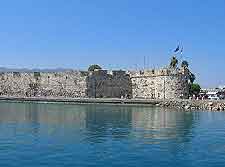
A number of historical landmarks and truly ancient monuments offer the opportunity to imagine how the island of Kos appeared many centuries ago, before the arrival of tourists and holiday resorts. Connected to the Plateia Platanou by the Finikon Bridge, which is also known as the Avenue of the Palms and crosses over what was once an imposing moat, the Castle of the Knights is one such landmark and was built to be nothing short of an impregnable fortress, defending Kos against possible attacks by the Ottomans.
Without question, the island's most important of all its ancient sites and landmarks is the Asklipieion. Located some 3 km / 2 miles from Kos Town, the Asklipieion ruins stand atop a high hill, covered in pine trees, and offer an insight into the grandeur of this former religious sanctuary to Asclepius (the Greek god of healing).
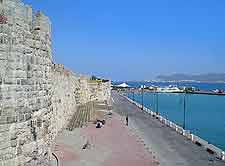
Castle of the Knights
Address: Leoforos Finikon, Kos, Greece, GR
Tel: +30 22420 27927
Constructed during the 14th century and surrounded by a large moat, the Castle of the Knights once featured enormous outer walls and an inner keep area, using large amounts of stone taken from the Agora site. The Castle of the Knights can be accessed through a well-preserved 16th-century gateway and a walk around the remains of its inner walls is something not to be missed, as too are the harbour views, which are quite delightful.
Open hours: Tuesday to Sunday - 08:00 to 14:30
Admission: charge
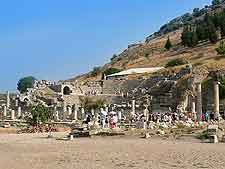
Ancient Agora
The archaeological site of Ancient Agora is an open-air landmark, residing directly to the south of the castle and the cobbled Plateia Platanou, and within Kos Town itself. On the western side of the Agora are the huge remains of the Great Hall (the Stoa), which features a number of reconstructed columns, providing a glimpse into its previous incarnation. The northern side of the Agora is home to many further remains, such as the Temple of Hercules, the 5th-century Christian Basilica, and also the Shrine of Aphrodite.
Open hours: daily
Admission: free
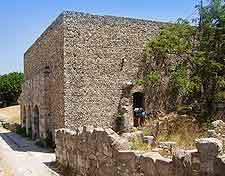
Western Excavation Site / Roman Nymphaeum (Nymphaion) / House of Europa Mosaics
Address: Grigoriou, Kos, Greece, GR
Opposite Grigoriou and on the western side of Kos Town, the Western Excavation Site is well you will discover some of the island's oldest archaeological attractions. The Western Excavation Site features a couple of large covered areas at the back, which provide protection to the mosaics of the House of Europe, which are known to be around 1,800 years old. Also here is an uncovered stretch of the Roman thoroughfare referred to as the 'Decumanus Maximums', as well as the Roman Nymphaeum ('vespassiani' / public urinals), the former 'Xysto' gymnasium, some imposing colonnades, courtyards, ancient swimming pools and the neighbouring remains of the Temple of Dionysos. The Roman Odeon Theatre is also close by and has recently been completely restored.
Open hours: daily
Admission: free
Synagogue
Once serving as an important place of worship for the island's Jewish community until their virtual demise following the events of WWII, the Synagogue is still a very impressive and important landmark to the past. Fully restored to its former glory, the Kos Synagogue was founded as long ago as 1747, although needed to be completely rebuilt after collapsing during a major earthquake in 1933. Various cultural events are staged here over the course of the year.
Open hours: daily
Admission: free
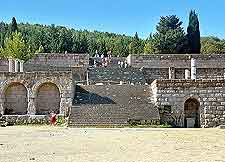
Asklipieion
Address: Asklipieion, Platani, Kos, Greece, GR
Tel: +30 22420 28763
Once part of Asklipieion was an influential school of medicine, which followed the findings of Hippocrates and attracted huge numbers of people to Kos, arriving from all over Greece, coming here to be both taught and also for medical treatment. Damaged during a major earthquake in the middle of the 6th century, the Asklipieion of today is remarkably well preserved, with many stone walls still standing and huge columns strewn across the floor. The remains occupy three different levels, with the first featuring the Roman baths and main entrance (propylaea), the second being home to the altar of Kyparissios Apollo (4th century BC) and the Temple to Apollo (1st century BC), and the third boasting the magnificent ruins of the Temple of Asclepius (2nd century BC).
Open hours: Tuesday to Sunday - 08:30 to 18:00
Admission: charge, discounts for children and students
 A number of historical landmarks and truly ancient monuments offer the opportunity to imagine how the island of Kos appeared many centuries ago, before the arrival of tourists and holiday resorts. Connected to the Plateia Platanou by the Finikon Bridge, which is also known as the Avenue of the Palms and crosses over what was once an imposing moat, the Castle of the Knights is one such landmark and was built to be nothing short of an impregnable fortress, defending Kos against possible attacks by the Ottomans.
A number of historical landmarks and truly ancient monuments offer the opportunity to imagine how the island of Kos appeared many centuries ago, before the arrival of tourists and holiday resorts. Connected to the Plateia Platanou by the Finikon Bridge, which is also known as the Avenue of the Palms and crosses over what was once an imposing moat, the Castle of the Knights is one such landmark and was built to be nothing short of an impregnable fortress, defending Kos against possible attacks by the Ottomans.


